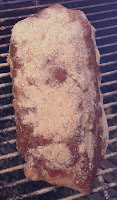While smoking a whole hog is indeed a huge production, smoking a pork shoulder or butt (aka Boston butt) is certainly doable for most people and well worth the time and effort. If you've always wanted to make real North Carolina barbecue that's fork-tender and succulent with a seductive smokiness that complements the natural meaty flavors in the pork, read on.
First, the good news: It's actually not hard to make perfectly edible and even tasty NC barbeque that's smoked, not baked or slow-cooked in a crock pot. The "bad" news is that it takes practice to achieve that blissful balance of spice, smoke, crunchy bark, juicily tender flesh and the pink halo of a smoke ring. But there are worse ways to spend your time than making and eating barbecue.
As with baking, variables like the weather (temperature and humidity) need to be taken into account when using a smoker, and wind can also be a factor, hence the need for practice. Greg has spent years honing his barbecue-making skills and practicing the art of turning a pork butt into real North Carolina BBQ. Here is his tried-and-true method, which has won him many friends, earned him the respect and envy of pros, and even seduced vegetarians into sneaking a bite and proclaiming it GOOD.
| Chimney Charcoal Starter |
Fill two charcoal chimneys with charcoal and light the coals (Greg uses crumpled newspaper as fuel). When the coals are red, dump them into the smoker and add a few chunks of oak (or a couple of handfuls of chips) to your smoker. Burn until the wood burns down to coals and no flame is present. Adjust the smoker vents so that the temperature gauge hits and maintains at 250°F. This is where science and art intersect, because you likely will need to monitor and adjust the vents from time to time to maintain the correct temperature for the entire cooking time. And there is no set amount of cooking time: As Greg likes to say, "it's done when it's done." There is no rushing good barbecue, and depending on the size of the pork butt and outdoor conditions (temperature, wind & humidity), it may take a few hours or all day--or even overnight and through the next day if you are smoking a whole hog in the middle of winter. But if you insist on additional information, when Greg made barbecue this weekend he used a 2 1/2 lb. very lean pork butt from a local farm (conventionally-raised pork will be fattier), and it took about 6 hours to smoke.
 |
| Rubbed & on the smoker |
Once the butt is on the smoker, leave it alone BUT periodically check the temperature of the smoker to make sure it remains at 250°F. Depending on whether the temperature fluctuates up or down before the butt is done, you may need to adjust the vents and/or add a little more charcoal (make sure you light it first and wait until the coals are glowing before adding to the smoker, or else you'll introduce unpleasantly harsh flavors).
"Fork-tender" is before "fall off the bone" tender, with the latter being overcooked and probably dry. The photo below shows Greg using the fork test to determine that the pork is done and ready to be removed from the smoker:
When it's done, transfer the butt onto a platter or tray and let it rest 15 minutes. You can see where Greg used the fork test:
 |
| Smoked Boston butt resting before pulling |
At this point, you can either transfer the pork into a bowl or pan for saucing, or serve it "unsauced" on plates or buns with a bottle of genuine North Carolina barbecue sauce handy so that diners can add sauce to add to taste. Good side dishes to serve include slaw and hush puppies, as well as collards or other greens, baked beans or seasoned green beans.
Zestfully yours,
Gloria
PS: If you're looking for real North Carolina BBQ sauce for your pulled pork barbecue, you'll find some of the best on our NC Products page, including eastern-style (vinegar) Wells Hog Heaven BBQ Sauce, spicy-hot eastern style Scott's BBQ Sauce, Piedmont or Lexington style (vinegar-tomato) Jim's Own BBQ Sauce, and western-style (more tomato plus vinegar) Bone Suckin' Sauce.





No comments:
Post a Comment